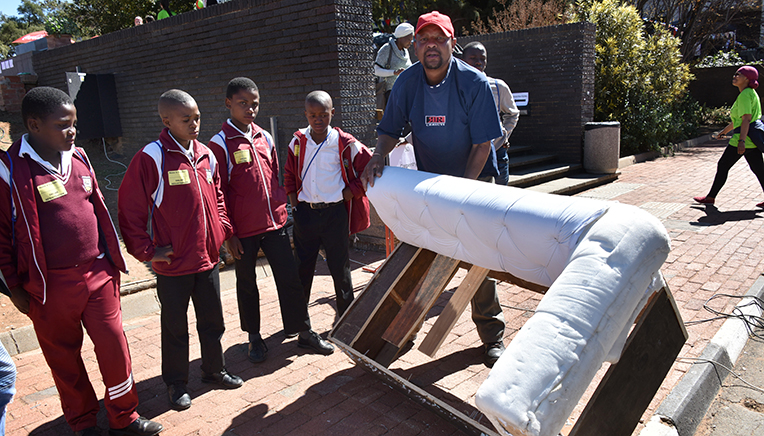This year saw the seventh Father Heart Engaged Learning Festival taking place on the Bloemfontein Campus of the University of the Free State. Sixty plus training providers exhibited at the festival, which was presented by the
UFS Directorate: Community Engagement.
Bishop Billyboy Ramahlele, Director of Community Engagement, says communities must take responsibility and use this opportunity to develop and empower themselves.
Save the environment
Acquiring new skills always results in personal development. One project, however, stood out as not only an opportunity to equip yourself, but also to save the environment.
Anita Venter from the Start Living Green grassroots-development initiative believes that more than a million species on the most endangered list will be extinct before 2050. Then there is also the climate crisis that we as humans are contributing to. The production of plastic (6,3 billion metric tons) is adding to this dire situation.
She believes that the use of eco-bricks can remove plastic from the system; you can manufacture your own furniture, thereby reducing the need to produce more plastic. “We can take responsibility for our own trash,” she said.
A brick consists of a two-litre plastic cold-drink bottle filled with pieces of plastic and paper. Several eco-bricks can be glued together to make benches and eco-brick modular furniture pieces. These pieces of furniture can be used in households or in institutions such as schools.
Love the jobKleinboy Trading Enterprises offered practical training with a hands-on approach. Focusing on carpentry, Mokhele Mokhele Kleinboy, who provided training at the learning festival for the fourth year, believes that teaching this skill to the youth keeps them off the streets. It also empowers them to either start their own business or find a job.
Find your truthMarié Olivier, the Director of Life Principles for Transformation, is helping dysfunctional individuals to flourish through her equine-assisted processes for personal growth. She believes one needs to be aware of situations in your life to be able to do something about them.
“The honest feedback from the horses in this process mirrors what is going on in your life and helps you to find your own truth. Once you have identified the obstacles and challenges you are faced with, you can make better choices.”
“It is a good process to differentiate between what is real and what is only going on in your head. If things in your life work out, the process with the horses will flow. If you get stuck in life, the process with the horses will get stuck.”
“This is not therapy, but a growth session,” explains Olivier.
At this year’s festival she worked with
Nicole Joubert, horse-behaviour specialist, dressage judge, provincial rider, and coach.
The equine-assisted process develops aspects such as personal discovery, promotes self-awareness, helps with identifying your strengths, and improve problem-solving skills. Olivier says their goal at the festival was to tell the community that they are available and that they can help to promote self-awareness and empower people.
Transferring your skills to the workplace, whether as a graduate or an entrepreneur, does not come easy for everyone.
Rosita Rhode, career development coordinator at the
Central University of Technology, presented a session aimed at empowering the attendees to communicate better, work better in a team, and improve self-management in a workplace situation.
 Mokhele Mokhele Kleinboy provided carpentry training for the fourth consecutive year at the Learning Festival.
Mokhele Mokhele Kleinboy provided carpentry training for the fourth consecutive year at the Learning Festival.
Paying it forward“It is our commitment that you should transform yourself and contribute to a better South Africa,” said
Prof Puleng LenkaBula, Vice-Rector: Institutional Change, Student Affairs, and Community Engagement at the UFS, on opening the learning festival.
Two attendees, Sibongile Mofokeng and Moipone Rakhale from the Qwaqwa Agape Foundation for Community Development, did just that.
“We will take the new skills we found at the festival back home to share it with the community,” said Mofokeng.
They attended sessions on woodwork and planting, as well as blanket-making and carpentry.
“We will teach and apply our new skills aimed at women empowerment, food and nutrition, and caring for persons of old age and orphans in the projects at the centre,” Mofokeng continued.
“We experienced love at the festival. People were happy; we talked to so many people – black, white. We are one nation with one heart,” concluded Rakhale.
Rakhale’s statement resonates with the late Izak Botes’ intention for the festival, namely, to share the Father’s Heart of love and to offer hope to many. According to Karen Venter, Head of the Service-Learning Division, Directorate: Community Engagement, Izak’s legacy will continue to live at the heart of the festival.
